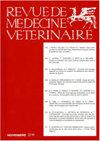Tripanosomiasis bovina en ganadería lechera de trópico alto: primer informe de Haematobia irritans como principal vector de T. vivax y T. evansi en Colombia
Q2 Veterinary
引用次数: 1
Abstract
Bovine trypanosomiasis is a hemoparasitic disease transmitted in Latin America mainly by biting flies of the family Tabanidae. The study aimed to evaluate infection by Trypanosoma vivax and Trypanosoma evansi in cattle specialized in milk production on a farm and their potential vectors. A direct parasitological and entomological study was performed using microscopy techniques and polymerase chain reaction (PCR) with two molecular markers to differentiate Trypanosoma species in blood samples of cattle and flies. Infection frequency with Trypanosoma vivax and Trypanosoma evansi in cattle was 3.6 and 0%, respectively. Characterization of vectors shows Haematobia irritans as the most frequent fly in the study area (97.1%), followed by Stomoxys calcitrans (2.8%). No horseflies were identified. T. vivax and T. evansi were found in proboscis and thorax-abdomen of biting flies Haematobia irritans and Stomoxys calcitrans , representing an epizootic behavior, atypical in South American countries. Due to its high population density, it is suggested that the Haematobia irritans fly is the main potential vector.热带高地奶牛的牛锥虫病:哥伦比亚首次报告刺激性嗜血杆菌作为间日疟原虫和埃文斯疟原虫的主要媒介
牛锥虫病是一种在拉丁美洲主要由Tabanidae科的叮咬蝇传播的血液寄生虫病。本研究旨在评价某农场产奶牛中间日锥虫和伊文氏锥虫的感染情况及其潜在的病媒。利用显微镜技术和聚合酶链反应(PCR)对牛和蝇的血液样本进行了直接的寄生虫学和昆虫学研究,并对两种分子标记进行了区分。牛中间日锥虫和伊文氏锥虫的感染率分别为3.6%和0%。媒介特征分析显示,研究区最常见的蝇类为刺激嗜血蝇(97.1%),其次为钙化口蝇(2.8%)。未发现马蝇。在吸血蝇的喙部和胸腹部发现间日绦虫和伊文氏绦虫,是一种动物行为,在南美国家不典型。由于其种群密度大,提示刺激嗜血蝇是主要的潜在媒介。
本文章由计算机程序翻译,如有差异,请以英文原文为准。
求助全文
约1分钟内获得全文
求助全文
来源期刊

Revue De Medecine Veterinaire
农林科学-兽医学
CiteScore
1.30
自引率
0.00%
发文量
0
审稿时长
18-36 weeks
期刊介绍:
The Revue de Médecine Vétérinaire publishes four kinds of text:
1) Scientific reviews on subjects related to veterinary and comparative medicine. Suggested length: 10 to 30 typed pages.
2) Original reports on fundamental or applied research. Suggested length: 10 to 15 typed pages.
3) Continuous education articles, that should be easily understandable by non-specialists. Suggested length: 10 to 15 typed pages.
4) Clinical reports. Suggested length: 5 to 15 typed pages.
The publication can be done in French language or English language.
For an article written in English by not english native speakers authors, the manuscript must be subjected by attesting that it was read again by an anglophone scientist or a scientific translator.
The authors must certify that the manuscript was not published or subjected for publication to another review.
The manuscript must be accompanied by a sheet signed by all the joint authors indicating their agreement for the tender of the manuscript.
The publication is free but a financial participation could be required for the photographs color. An estimate will be sent to collect the agreement of the authors.
 求助内容:
求助内容: 应助结果提醒方式:
应助结果提醒方式:


